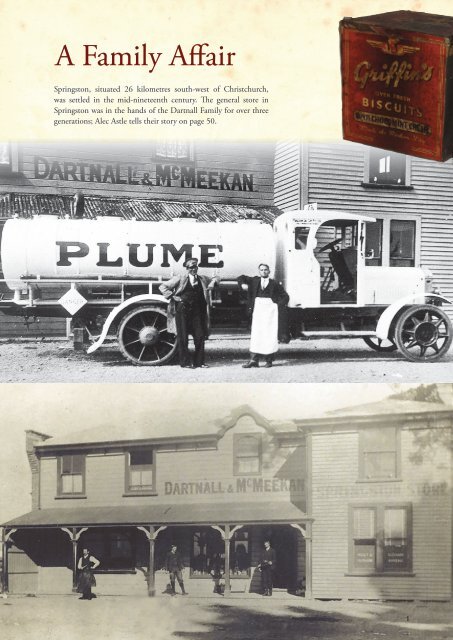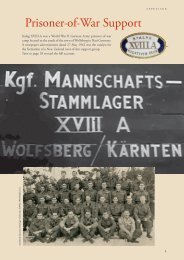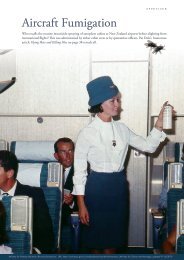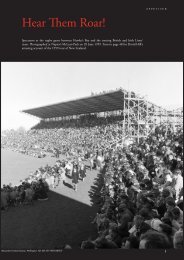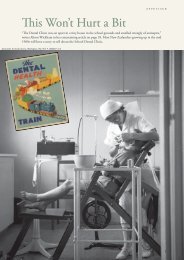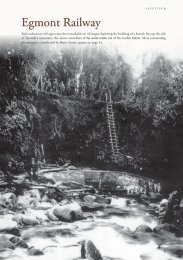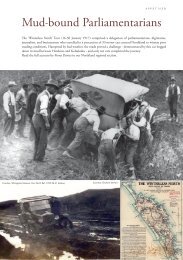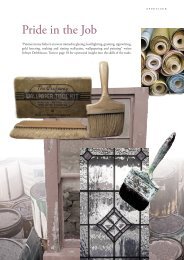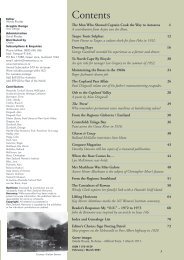Create successful ePaper yourself
Turn your PDF publications into a flip-book with our unique Google optimized e-Paper software.
APPETISER<br />
A Family Affair<br />
Springston, situated 26 kilometres south-west of Christchurch,<br />
was settled in the mid-nineteenth century. The general store in<br />
Springston was in the hands of the Dartnall Family <strong>for</strong> over three<br />
generations; Alec Astle tells their story on page 50.<br />
1
EDITORIAL<br />
Dear Readers,<br />
In our striking cover photograph, the Auckland Tramping Club pause at the<br />
Commercial Hotel in Dargaville be<strong>for</strong>e continuing onto the Waipoua Forest <strong>for</strong><br />
a tramping expedition. It’s interesting to note the outfits in 1928; suit and ties<br />
<strong>for</strong> men and dresses, coats and hats <strong>for</strong> the women… and on the back of a truck.<br />
Fashion trends have certainly become more casual over the years. Even moving<br />
<strong>for</strong>ward to 1964, Ralph Levinson writes in his account of Joining the Work<strong>for</strong>ce,<br />
“I owned two white shirts and one pair of shoes – each evening I washed a shirt,<br />
pressed the other and polished my shoes”. Of course it seems contradictory (and<br />
laughable) nowadays that these same men’s <strong>for</strong>mal shirts, ties and black shoes were<br />
combined with ‘dress’ shorts and long socks as summer workplace attire <strong>for</strong> the office.<br />
And moving on to uni<strong>for</strong>ms of an entirely different variety; who amongst our readers belonged to the Scouting<br />
Movement? Perhaps you attended the same 1959 Jubilee described in David Hill’s article and prepared to ‘Be<br />
Prepared’ no matter what. Man-powered employee Joan Leonard sewed Relax brand raincoats <strong>for</strong> servicemen<br />
during the war years - not that much relaxing would have been on the cards <strong>for</strong> World War II soldiers!<br />
Onto other topics, Alec Astle profiles the remarkable Dartnall Family who operated a Canterbury general store<br />
<strong>for</strong> three generations, Mick Hodder’s remarkable leading story relates to his upbringing in a railway house<br />
during the 1930s and Wendy Clark remembers the ‘night soil man’ on Auckland’s North Shore.<br />
John Stackhouse, an author with a taste <strong>for</strong> the unusual, is welcomed back with a ‘Whodunnit’ <strong>for</strong> readers to<br />
puzzle. The intriguing collection of illustrative cartoons gives readers a glimpse of the First World War through<br />
the eyes of a New Zealand soldier.<br />
Nothing beats enjoying a good read on a cold wintry afternoon and our authors have contributed an assortment<br />
of worthy stories in this <strong>157</strong>th edition.<br />
Keep warm and stay well,<br />
Wendy Rhodes,<br />
Editor<br />
For just $57 you receive four superb<br />
issues of New Zealand Memories<br />
direct to your letterbox.<br />
A G i f t o f D i s t i n c t i o n<br />
Surprise a friend or relative with a gift. We will gift<br />
wrap the first issue, include a gift card with your<br />
personal message and post it direct.<br />
Freephone: 0800 696 366 or<br />
Freepost: 91641<br />
PO Box 17288<br />
Green Lane, Auckland 1546<br />
Email: admin@memories.co.nz<br />
Visit our website w w w.memories.co.nz <strong>for</strong> back issues and gift ideas.<br />
Order online securely today and pay via internet banking or credit card.<br />
2
Editor<br />
Wendy Rhodes<br />
Graphic Design<br />
Icon Design<br />
Administration<br />
David Rhodes<br />
Distributed by<br />
Are Direct<br />
Subscriptions & Enquiries<br />
Phone tollfree: 0800 696 366<br />
Mail: Freepost 91641,<br />
PO Box 17288, Greenlane, Auckland 1546<br />
email: admin@memories.co.nz<br />
www.memories.co.nz<br />
$57 <strong>for</strong> four issues<br />
(Price includes postage within NZ)<br />
Contributors<br />
Alexander Turnbull Library, Wellington,NZ<br />
Astle, Alec<br />
Auckland Libraries Heritage Collection<br />
Clark, Wendy<br />
Clover, Ken<br />
Dove, Rodney<br />
Hill, David<br />
Hirst, Helen<br />
Hodder Alan<br />
Janes,Terry<br />
Leonard, Joan<br />
Levinson, Ralph<br />
Nelson Provincial Museum<br />
Paeroa and Districts Historical Society<br />
Pickmere, Alan<br />
Rhodes, Donald<br />
Smith Judith<br />
Smith, Malcolm<br />
Stackhouse, John<br />
Stewart, Graham<br />
Subritzky, Mike<br />
Tairawhiti Museum<br />
Ujdur, S<br />
Veronese-Cowell, Tania<br />
Veronese, Zeff<br />
Waipu Museum<br />
Whakatane District Museum<br />
Opinions: Expressed by contributors are not<br />
necessarily those of New Zealand Memories.<br />
Accuracy: While every ef<strong>for</strong>t has been made to<br />
present accurate in<strong>for</strong>mation, the publishers take no<br />
responsibility <strong>for</strong> errors or omissions.<br />
Copyright: All material as presented in<br />
New Zealand Memories is copyright to the publishers<br />
or the individual contributors as credited.<br />
Contents<br />
Life on the Railways 4<br />
Alan (Mick) Hodder grew up in a railway worker’s cottage in the 1930s.<br />
Scouting Around 8<br />
Off to the Pan-Pacific Jamboree with David Hill.<br />
Ampelio Saves the Pilot 11<br />
A tall but true tale from Zeff Veronese.<br />
There’s No Town Like It! 12<br />
Malcolm Smith taught at Blackball between 1961 and 1963.<br />
Off to Sunday School: Rangiora, 1934 15<br />
Helen Hirst’s introduction to St Mary’s Church.<br />
From the Regions: Coromandel / Bay of Plenty 16<br />
Joining the Work<strong>for</strong>ce 28<br />
Ralph Levinson started work as an insurance clerk in 1964.<br />
Man Powered 34<br />
Joan Leonard helped the war ef<strong>for</strong>t in 1944.<br />
Centrefold: When Duty Calls 36<br />
Nelson Troop 4th Contingent photographed on 27 February 1900.<br />
The Great Cartoon ‘Whodunnit’ 38<br />
John Stackhouse solves a World War One puzzle.<br />
The Scows 48<br />
Early New Zealand cargo vessels are examined by John Newsham.<br />
Dartnall Family General Store at Springston 50<br />
Alec Astle follows ninety years of retail ownership.<br />
The Night Soil Collection 56<br />
Wendy Clark discusses a delicate subject.<br />
From the Regions: Northland 58<br />
Reader’s Response 68<br />
Happy 150th Birthday SPCA<br />
Mailbox 69<br />
Index and Genealogy List 70<br />
Editor’s Choice: Snowy Queenstown in 1934 72<br />
ISSN 1173-4159<br />
June/July 2022<br />
Auckland Libraries Heritage Collections 282-471<br />
Cover image:<br />
Members of the Auckland<br />
Tramping Club outside<br />
the Commercial Hotel,<br />
Dargaville c.1928.<br />
3
STORY<br />
4
STORY<br />
Life on the Railways<br />
Alan (Mick) Hodder<br />
I<br />
grew up on the railway at Whangaehu in the 1930s. Our house was so close to the track that when we<br />
went out the gate, we often found ourselves walking through steam. Trains went by about every two<br />
hours, mainly carrying freight, with one passenger carriage. It was the only means of transport <strong>for</strong> the<br />
majority of farmers as most didn’t own a car. There were a few Essexes and Fords on the road and, towards<br />
the end of the thirties, a few American cars appeared.<br />
Shopping meant catching the train to Whanganui; heavy items were placed in the guards van, usually by the<br />
supplier, but the rest had to be carried in the passenger carriage (including 25lb bags of flour and 40lb bags<br />
of sugar). Two expresses (the 595 and the 610 from New Plymouth to Wellington) and vice versa were also<br />
regular runs. I remember being on a train going to Whanganui in 1931 when it suddenly stopped and the<br />
guardsman came hurrying through the carriage to see what had happened. There was a shaking… the Hawke’s<br />
Bay earthquake had struck!<br />
Our house was a railway worker’s cottage with no electricity, two water taps (only cold water from both - hot<br />
water had to be heated on the black Orion coal fired range and carried to the kitchen sink) and lighting from a<br />
kerosene lamp in the middle of the table or by candles. Sunday was bath day and the hot water had to be carried<br />
to the wash house, several yards from the back door.<br />
5
STORY<br />
Railway workers were allowed to fence off what was<br />
known as the ‘long acre’, a half mile strip of railway<br />
reserve; one side was the day paddock, the other the<br />
night. We hand milked two or three cows on the long<br />
acre and the milk was separated with the cream being<br />
collected by the factory lorry. We also raised two pigs<br />
each year. Sides of bacon meat hung in the kitchen. A<br />
large vegetable garden included an area <strong>for</strong> small fruits<br />
(blackcurrants, gooseberry and raspberries) and we also<br />
raised ‘chooks’. Their eggs were preserved in Norton’s<br />
egg mixture in a bucket. Sometimes it worked!<br />
Both the butcher and the baker called once a week,<br />
and a tinker sold material, cottons, buttons and the<br />
like. The tinkers mode of transport, a horse and<br />
wagon, was also his home.<br />
Growing up as boy in the Depression meant you<br />
lived life to the full. Because of lack of company, I hung<br />
about the station and learned how to fold tarpaulins<br />
by watching, then helping, the station master.<br />
One train I remember well was the circus train -<br />
Wirth’s Circus perhaps - that came by. It didn’t stop<br />
at Whangaehu but we watched it as it went by. It was<br />
about a half a mile long, pulled by two AB engines<br />
and pushed by a WW engine. There was a long uphill<br />
section just after Whangaehu around a curved section<br />
which we could see from the station. The trains were<br />
so long and hadn’t enough power to get up the incline,<br />
so they had to disconnect half the wagons, take the<br />
first half up to a siding at Baker ‘s crossing, go back<br />
and collect the rest and take them up and reconnect<br />
the whole train be<strong>for</strong>e proceeding on to Fordell. The<br />
WW gave extra power to do the shunting.<br />
My father was in charge of a team of four or five men;<br />
his title was ‘ganger’ and the others were ‘surface men’.<br />
They were responsible <strong>for</strong> maintaining nine miles of<br />
track which involved chipping weeds and replacing<br />
wooden sleepers. My dad was also responsible <strong>for</strong><br />
burying animals caught up by a passing engine. One<br />
day the 3:30 reported running through a mob of sheep<br />
near Ratana. Dad hopped on the hand jigger to go<br />
clean up the mess, but found very little evidence when<br />
he got there. The locals had taken care of it – cheap<br />
meat!<br />
The team also carried out minor repairs on the<br />
track. Late one afternoon, while they were unloading<br />
full lengths of rail <strong>for</strong> a deviation <strong>for</strong> the new railway<br />
bridge, one went rogue and caught my father’s ankle.<br />
He hobbled home and realized his foot was not right,<br />
so spent most of the night with his foot under the<br />
garden water tap. Using two brooms as crutches, he<br />
got on the first train to Whanganui and came home<br />
with his foot in plaster.<br />
My father regularly checked the tracks, paying<br />
particular attention to the curves. A member of the<br />
family accompanied him on a Saturday bringing home<br />
mushrooms and watercress from the drains on the side<br />
of the rack, and manuka <strong>for</strong> pea stakes. The buckets<br />
were 4-gallon kerosene cans with the tops cut off and<br />
number 8 wire as handles.<br />
Every now and then steam engines needed to refill<br />
their water tenders from a big water tank next to our<br />
house. The fireman needed to climb up on the tender<br />
to do so. It was amazing how much coal fell off during<br />
this process. Needless to say it didn’t stay on the<br />
ground very long - we kids had friends in high places!<br />
The Whangaehu River was notorious <strong>for</strong> flooding.<br />
The first flood I remember was in the late 1920s. It<br />
got so bad that Dad and the team laid the piano on<br />
its back on the kitchen table. The task of keeping the<br />
bridge piers clean of debris which often came down<br />
in the floods was a challenge. The only way was to go<br />
down and saw through the offending rubbish to free<br />
the jam. Once one of the gang was standing on a pile<br />
of debris, while trying to clear it, when it gave way<br />
and he was swept downstream clinging to a piece of<br />
rubbish ending up on a sandbank downstream.<br />
My schooling took place about a mile away. There<br />
were two teachers, one <strong>for</strong> each of the Infants and<br />
Standards. Initially everybody had slates in their desk<br />
with pencils; later we had pens with ink in small china<br />
pots. There was a horse paddock <strong>for</strong> those who rode to<br />
school, otherwise pupils walked. A plot in the horse<br />
paddock was fenced off <strong>for</strong> children to grow vegetables<br />
and cow tucker, such as mangles. School attendance<br />
was fairly good. A pink certificate was presented if you<br />
didn’t miss more than five half days in the year. The<br />
famous Dr. Gunn checked over our health yearly.<br />
One <strong>for</strong>m of entertainment was ‘spinning the top’.<br />
A string was wound around the top and then thrown;<br />
success depended a lot on the quality. Some pupils<br />
could keep their top spinning by using a whip. Those<br />
who couldn’t af<strong>for</strong>d to buy one used a pine cone.<br />
Hopscotch was another popular playground game.<br />
Sunday dinner was a major event. There was always<br />
someone from the valley, or fellow railway workers,<br />
as guests. While the railway bridge was being built,<br />
construction workers lived in huts on flatbed wagons<br />
parked in the station yard. One hut was home <strong>for</strong> a<br />
married man with a wife and two children, and my<br />
mother often had them over <strong>for</strong> a meal. Imagine<br />
cooking a Sunday roast meal on a coal-fired stove kept<br />
hot by constantly feeding coal! A pudding was always<br />
6
STORY<br />
“A large vegetable garden included an area <strong>for</strong> small fruits (blackcurrants,<br />
gooseberry and raspberries) and we also raised ‘chooks’. Their eggs were<br />
preserved in Norton’s egg mixture in a bucket. Sometimes it worked!”<br />
served up in those days – on good china and a starched table cloth. My fond memories are of Mum’s apple pies<br />
and rice puddings. We lived well.<br />
There were no fridges. Milk and meat were kept in a metal safe which hung underneath the water tanks. Meals<br />
were prepared in the kitchen, called a scullery. Surplus produce during the growing season was stored in the<br />
scullery <strong>for</strong> a later date. Every shelf was filled with spare fruit in big Agee preserving jars as well as jams, pickles<br />
and relish in smaller jars with paper tops glued down to seal. Keeping tops on homemade ginger beer was a<br />
problem – the corks had to be tied down with string. Perhaps there might have been a little ‘extra’ in it!<br />
I still have my mother’s recipe book, neatly written in, I think, copper plate style although sadly a little worse<br />
<strong>for</strong> wear. My granddaughter, who lives in Ottawa, rang recently <strong>for</strong> my mother’s tomato sauce recipe from the<br />
treasured book. In the back of the book are handy hints recipes <strong>for</strong> household use:<br />
“Stove polish: turpentine, Zebra paste, black lead, baking soda and ammonia.<br />
Soap making: fat, borax, caustic soda, resin and water.<br />
Floor polish: Lux flakes, CO polish and water.<br />
Repulsing ants: boracic powder, sugar and water.”<br />
Our family left the house by the railway track soon after the 1936 flood, moving into town where we had<br />
electric lights and a flush toilet. And where we could purchase ready-made clothes to replace underwear made<br />
from flour bags.<br />
Growing up on the railway didn’t hurt my sisters and I… we’ve all lived well into our nineties. n<br />
7
STORY<br />
Scouting Around<br />
David Hill<br />
January 1, 1959. Over 120 of us marched off from Napier’s<br />
Tiffen Park, around past Clive Square, towards the Railway<br />
Station. The 14 to17-year-olds were in front, pretty much<br />
in step, thanks to the Army Cadet training we had at high<br />
school. The young ones straggled behind, pretty much not in step.<br />
We wore our khaki shirts with epaulettes and badges, our kneelength<br />
socks with green or scarlet garter tabs, our lemon-sqeezer<br />
hats. Rows of Boy Scouts, on our way to the Pan-Pacific Jamboree,<br />
at Cornwall Park in Auckland.<br />
“Jamboree” means a big gathering of Scouts. It’s a wonderful<br />
word, apparently invented by Lord Baden-Powell, Boer War hero<br />
and founder of Scouting. When asked why he called it that, B-P is<br />
said to have smiled and replied “What else could you call it?”<br />
The week-long 1959 assembly brought 8000-plus Scouts,<br />
Rovers (the senior branch) and Scoutmasters from Australia, the<br />
United Kingdom, Canada, the Pacific, most other countries of<br />
the British Empire – already on its way to becoming the British<br />
Commonwealth. And of course from all over New Zealand.<br />
Eight thousand: it was an astonishing feat of logistics in preemail,<br />
pre-cellphone, unreliable toll-call days. So astonishing, that<br />
we teenagers took it <strong>for</strong> granted.<br />
We reached the railway station. Peter Tait, Napier’s mayor <strong>for</strong><br />
an unprecedented six terms, addressed us, and I apologise <strong>for</strong> not<br />
remembering a single word His Worship said. We steamed off in a<br />
special train, stopping at Hastings, Waipawa, Waipukurau, Otane,<br />
Norsewood and Dannevirke to pick up more scouts, be<strong>for</strong>e a paper<br />
bag tea at Palmerston North. Imagine a passenger train stopping at<br />
those little stations these days. Actually, imagine a passenger train<br />
these days.<br />
I’ve still got my Jamboree Logbook, “With the Compliments<br />
of THE NATIONAL BANK of New Zealand Ltd”. Anyone<br />
remember that name? My spiky, 16-year-old’s handwriting and its<br />
stiff prose shows how much was crammed into the jamboree’s eight<br />
days.<br />
“Crammed” described the train as well. I’d naively asked<br />
my parents “Will there be beds on the train? Should I take my<br />
pyjamas?” Mum and Dad smiled. It was my first experience of<br />
sleeping on an a NZR seat, with all the flexibility and softness of<br />
a park bench.<br />
We reached Greenlane Station at 6 a.m. next day, and marched<br />
about two miles to Smith Sub-Camp, behind the stone walls of<br />
Cornwall Park. My first time in Auckland. My first jamboree. I was<br />
levitating with excitement.<br />
The 8000 were divided into about ten sub-camps, along both<br />
sides of Greenlane Road, around Alexandra and Cornwall Parks.<br />
Each sub-camp was named after a significant person or place in<br />
NZ scouting, and each had a ceremonial gateway.<br />
8
STORY<br />
I have no photos; I had no camera (we’re talking bulky Box Brownies then), but I remember the Aussies’<br />
entrance: a giant bamboo pylon, plus an emu made from ropes’ ends. Another gateway was covered with stags’<br />
heads; a third featured a volcano with a genuine fire on top.<br />
At the March Past and Opening Ceremony, we trooped into Alexandra Park in our youthful thousands. I<br />
carried the Napier Contingent flag, and knew that life couldn’t get more wonderful, even if the lone scout from<br />
Ceylon (as it was still called then) got a bigger cheer than Napier’s 120.<br />
Governor-General and swashbuckling cricketer Lord Cobham spoke to us. So did Prime Minister Walter<br />
Nash and Opposition Leader Keith Holyoake, and I apologise again, but I can’t remember a word any of those<br />
distinguished gents said, either. But I do recall being struck by the PM’s gravelly Birmingham voice, and Kiwi<br />
Keith’s broad NZ vowels, while the Gov-Gen sounded just like a BBC newsreader.<br />
All through the Jamboree, the official programme kept us busy. There was a Scouts’ Own Church Service on<br />
the slopes of One Tree Hill, lit by hundreds of torches. There were presentations and per<strong>for</strong>mances by every<br />
district. Otago re-enacted the Relief of Mafeking, which made Baden-Powell into a national hero. Fiji did “a<br />
spear dance”, in my logbook’s unimaginative words. The Sea Scouts showed the history of whaling in New<br />
Zealand. There were displays by Girl Guides, Brownies, The Boy’s Brigade. (Who recalls that lively, Christianbased<br />
youth organisation?)<br />
We were given free entry to the stock-car racing at Alexandra Park, and my logbook eagerly noted that “one<br />
car turned over and caught alight”. Buses took us to the Auckland Museum, from where I saw the almostcompleted<br />
span of the Harbour Bridge.<br />
The campsite at the Pan Pacific Scout Jamboree in Cornwall Park, Auckland in January 1959.<br />
Courtesy: Auckland Libraries Heritage Collections 1207-639<br />
9
Alexander Turnbull Library, Wellington, NZ. Ref: Eph-A-WAR-SA-1900-04-cover<br />
36
When Duty Calls<br />
Nelson Troop 4th Contingent photographed on 27 February 1900 by Henry Brusewitz. The six riflemen in<br />
military uni<strong>for</strong>m prepare to serve King and Country in the South African (Boer) War (11 October 1899<br />
to 31 May 1902). To qualify as a mounted rifleman, each candidate needed to be in good physical health,<br />
an accomplished horse rider and, if possible, own his own horse. The photographer, Swedish-born Henry<br />
Brusewitz, worked from premises in Waimea Street (now Ruther<strong>for</strong>d Street) Nelson in 1900.<br />
Nelson Provincial Museum Pupuri Taonga o Te Tai Ao. HBZ 6x8 703 4th Contingent 27 2 1900 30296R~1 riflemen on horse.<br />
37
FEATURE<br />
The Great Cartoon<br />
‘Whodunnit’<br />
John Stackhouse<br />
Hiscocks or Prain?<br />
Who was the artist who penned these cartoons in the Great War to end All Wars?<br />
A set of World War One cartoons caught my eye recently, all unsigned and advertised as by an unknown artist.<br />
The smell of a story and a challenge could not be resisted, so I managed to secure a number of the black and<br />
white originals.<br />
There were many clues and, even better, there were self-portraits. Not quite as good as 21st century CCTV<br />
footage, but there he is, pipe between his teeth, ink pot by his foot, hair swept up and a disgruntled look. He had<br />
a distinctive drawing style, progressive <strong>for</strong> the time, as I learnt through research. But <strong>for</strong> all the in<strong>for</strong>mation, who<br />
was he? After much comparison of known, signed drawings by New Zealand cartoonists, it came down to two<br />
names, Hiscocks or Prain? Prain or Hiscocks? A sort of cartoonist’s ‘whodunnit’.<br />
Well, here is the evidence. What are your thoughts?<br />
A set of cartoons<br />
World War One was reported widely, as no other war<br />
had been be<strong>for</strong>e. Not only did this happen through<br />
the press and official government channels, but also<br />
through the letters, postcards and photographs of<br />
the ‘everyday’ soldier who was involved. This, at the<br />
time, was an ‘in<strong>for</strong>mation wave’ when compared to<br />
reporting and recording of past conflicts.<br />
A generally overlooked record was also being made<br />
by cartoonists, often serving as ordinary soldiers, who<br />
took pencils, pens, ink and paper as essential items<br />
with them and recorded their war. They give us a<br />
very different glimpse of war <strong>for</strong> the ordinary soldier<br />
but their day-to-day records in the <strong>for</strong>m of their own<br />
personal cartoons, seldom surface. Their personal<br />
cartoons mostly remained unsigned and unpublished.<br />
In the case of those illustrating this article, it seems<br />
all but one are ‘working sketches’, the basis <strong>for</strong> more<br />
detailed cartoons and illustrations to be completed at a<br />
later date. In just a few sketched lines cartoonists told<br />
their unique, visual stories.<br />
Originally there were over twenty cartoons as a<br />
group, but I did not manage to purchase them all.<br />
The twenty covered aspects of the trip to England via<br />
Egypt, a couple of figures sketched in Panama, some<br />
in Egypt, his time in England and on the Western<br />
Front. There most probably were many more than<br />
these at one time.<br />
This article gives a glimpse of the life of two New<br />
Zealand cartoonists actively serving in World War<br />
One and includes a small sample of a unique, personal<br />
record of war.<br />
These men were:<br />
2/314 Gunner Eceldoune Frederick Hiscocks,<br />
born ‘May 1881’ in Australia to English parents.<br />
Noted as ‘horse breaker’. That is what Fred Hiscocks<br />
told the recruiters behind the army recruitment desk<br />
on 21 August 1914 when he went from his home in<br />
Seatoun to Wellington city to enlist. Much of the<br />
in<strong>for</strong>mation given was correct. However, he was in<br />
fact born on 19 April 1879 and he was at the time of<br />
enlistment a well-known New Zealand cartoonist. But<br />
because of his age, old <strong>for</strong> a recruit at the time, and his<br />
occupation of cartoonist, not a skill sought after by the<br />
army to defeat the Kaiser’s ambitions, Fred Hiscocks<br />
decided to change a detail or two in his favour.<br />
So his life began as a gunner in the New Zealand<br />
artillery, a somewhat different occupation to that of<br />
one of New Zealand’s leading cartoonists. Off with the<br />
‘Main Body’ of the New Zealand Expeditionary Force<br />
to Gallipoli in October 1914 and then to France. He<br />
remained in England after the war and worked as a<br />
cartoonist <strong>for</strong> a variety of publications and drew <strong>for</strong><br />
early animated cartoons.<br />
24/1520 Lance Corporal George Gordon Prain<br />
was born in Dunedin in 1892 into an early Otago<br />
pioneer family. The eldest boy of four he also had<br />
one sister. His mother died pre-war, his father dying<br />
unexpectedly in October 1914, tragedy seeming<br />
to striking the Prain family regularly. Brother<br />
Harry, badly wounded 8 August 1915 in the Otago<br />
Regiment’s actions on Chunuk Bair, Gallipoli, died<br />
in an accident at Levin in 1922. Another brother,<br />
38
FEATURE<br />
It’s not easy being a cartoonist at war!<br />
39
FEATURE<br />
Alexander, was killed in action on the Somme, 15 September 1916, also a member of the Otago Regiment.<br />
George’s youngest brother, Robert, was just too young <strong>for</strong> active service. George was also wounded in June<br />
1918, but fully recovered.<br />
George left <strong>for</strong> the war as a member of the 8th Rein<strong>for</strong>cements in late 1915, a short stop in Egypt and then<br />
to France as a member of the New Zealand Rifle Brigade. He returned to New Zealand and made his mark as a<br />
cartoonist in New Zealand and Australian publications.<br />
The Challenges of Cartoonists at War.<br />
As shown in the previous cartoon set (on page 39), this cartoonist did persevere with his cartooning under<br />
what would have been very varied and challenging circumstances through years of war. Although he clearly<br />
abandoned his short-lived pursuit of a History of the Great War, he did, however, leave a valuable record of war<br />
in his distinctive style.<br />
The Western Front: Making the Best of it!<br />
The artist’s reintroduction to France was the same as many of New<br />
Zealand’s soldiers, via the camp at Etaples, in Picardy. Then on to<br />
the Somme. The New Zealanders became well known, maybe even<br />
notorious, to the French <strong>for</strong> a variety of reasons. The cartoonist was<br />
certain the French would remember the New Zealanders long after<br />
the war had ended.<br />
In fact he goes on to provide a design <strong>for</strong> a proposed monument (at<br />
right) to the New Zealanders to be erected in Picardy.<br />
(‘Onward N.Z.’, as noted on the plinth of the proposed monument,<br />
were the words on the New Zealand Expeditionary Force badge worn<br />
on New Zealand uni<strong>for</strong>ms.)<br />
40
FEATURE<br />
Although clearly an amusing jibe at the pomposity of many monuments to the rich, famous and their deeds,<br />
this figure embodies the tone of the artist’s cartoons at this time. They highlight the ordinary New Zealand<br />
soldier trying day to day to make the best of an often quite dismal existence. To the artist the New Zealand<br />
soldier was a resourceful realist. The French of Picardy admired the New Zealanders as soldiers but were often<br />
the ‘victims’ of his resourcefulness, as many a chicken owner knew all too well!<br />
By contrast George Prain designed a 1918 Christmas Card <strong>for</strong> the New Zealand Rifle Brigade. It contrasts in<br />
context sharply with the cartoon below. In 1916, the war was a seemingly never ending blood and mud bath.<br />
By Christmas 1918, the war had ended, hope was returning.<br />
Christmas and New Year soon arrived, dismal weather<br />
after the bloodbaths of the Battles of the Somme. This<br />
was the worst winter in Europe <strong>for</strong> decades. The artist<br />
turned his thoughts towards Christmas and New Year.<br />
His ‘Design <strong>for</strong> a Xmas Card’ encapsulates his thoughts<br />
of Christmas <strong>for</strong> the men at the Front... not a cheerful<br />
scene. It is a very apt interpretation as the men on<br />
the Western Front struggled to gain any cheer from a<br />
freezing, wet Christmas in the trenches.<br />
The men admired the artillery observers who hung<br />
precariously in baskets below very vulnerable observation<br />
balloons, but they certainly didn’t envy them. German<br />
gunfire and aeroplanes often wreaked havoc on the<br />
balloons, but at least the observer had a parachute to help<br />
him escape harm, a ‘luxury’ the men of the air <strong>for</strong>ce at the<br />
time did not have. The cartoonist recorded an instance of a<br />
lucky observer who jumped <strong>for</strong> his life amidst the German<br />
shrapnel shell bursts.<br />
41
INDEX and GENEALOGY LIST<br />
A<br />
ABLE Mr & Mrs 55<br />
Ahipara 59<br />
ALPS Mr & Mrs 55<br />
animal welfare 68<br />
Aratapu 67<br />
Army Cadets 8<br />
Army Camp (Opua) 62<br />
Arthur Skelton's Band 32<br />
artist 13<br />
Auckland 8,28<br />
Auckland Bus Co. 28<br />
Auckland City 29<br />
Auckland Tramping Club 66<br />
Awanui Beach 58<br />
B<br />
babies (district nurse) 60<br />
BANKS Sir Joseph 16<br />
Barwick's Auction Mart 69<br />
Battenburg cake 30<br />
Bay of Islands 62<br />
Bay of Plenty 24<br />
BAYLDON Francis 17<br />
BIGGS Mr & Mrs 55<br />
BIRCHALL Deaconess 15<br />
Blackball 12<br />
Blackball mine 12<br />
Blackball School 12<br />
Boer War 36<br />
Boy Scouts 8<br />
BRICKELL Barry 31<br />
Brown's Mill 31<br />
BRUSEWITZ Henry 36<br />
Burlington Tea Rooms 30<br />
bushman's camp 26<br />
C<br />
CAMPBELL Mr HH. 65<br />
Canterbury 50<br />
cartoonist 38<br />
cartoons 38<br />
CASTLE Len 31<br />
Chandris Line 33<br />
Christchurch 52<br />
CLARKIN Pat 23<br />
coal (Blackball) 13<br />
COBHAM Lord 9<br />
Commercial Hotel (Dargaville) 66<br />
commuting (Auckland) 28<br />
COOK Capt. James 16<br />
cooking (coal range) 7<br />
Cornwall Park 8<br />
Coromandel 17<br />
Coronation Hotel 65<br />
Croations 66<br />
Cruickshank, Miller & Co. 31<br />
Crystal Palace 32<br />
D<br />
dance venues 32<br />
Dargaville 66<br />
DARROCH Davey 48<br />
DARTNALL Arthur 51<br />
Audrey 52<br />
Clement 51<br />
Cyril 52<br />
Edmund 50<br />
Henry 50<br />
Henry Lloyd 51<br />
DARTNALL Henry Martin 52<br />
Howard 50<br />
Lucy 50<br />
Mabel 52<br />
Neville 52<br />
Pauline 52<br />
Percy 51<br />
Sarah 51<br />
William 1,50<br />
Winifred 52<br />
Dartnall & Co. 51<br />
Dartnall & McMeekan 51<br />
Dartnall Bros. 52<br />
department stores (Auckland) 31<br />
Depression 6<br />
District Nurse 60<br />
dog registration (1898) 61<br />
dog tax' 61<br />
Doyleston 50<br />
DUDLEY Archdeacon B.W. 15<br />
DUFTY Todd 20<br />
DUSKY Mrs 15<br />
DYSON William 46<br />
E<br />
EARP George 19<br />
EBAN Mr 56<br />
education 6<br />
effluent 56<br />
EGGINTON Ray 567<br />
emigartion 19<br />
emigrant's clothing 19<br />
employment 28<br />
essential industry (WWII) 34<br />
F<br />
Fairbairne Wright & Co. 52<br />
farming (Thames) 20<br />
fashion (1960s) 32<br />
Flagstaff Hill (Russell) 63<br />
flax milling 20<br />
food delivery 54<br />
FORNASIERO Ampelio 11<br />
Evelina 11<br />
<strong>for</strong>tified village 27<br />
Fortress Bay of Islands 62<br />
FRIZZEL Mabel 52<br />
G<br />
Galaxie 32<br />
Gallipoli 38<br />
ganger (railway) 6<br />
General Store 1,50<br />
George Roy Ltd 50<br />
George Walker Ltd 31<br />
gold diggers 19<br />
goldfields 18,23<br />
government <strong>for</strong>ces (1898) 61<br />
GREEN Audrey 52<br />
Greenlane 8<br />
groceries 54<br />
Guardian Assurance 28<br />
gumdiggers 66<br />
GUNN Doctor 6<br />
H<br />
HAMILTON Laurie 50<br />
hand tools 30<br />
handy hints 7<br />
Hauraki Plains 20<br />
Hawke's Bay Earthquake 5<br />
HAWKES Wayne 32<br />
HIRST Helen 15<br />
Joan 15<br />
HISCOCKS Eceldoine Frederick 38<br />
HOGAN Edward 56<br />
HOLLAND Nathaniel 16<br />
HOLYOAKE Keith 9<br />
horse teams 23<br />
horses (Boer War) 36<br />
HOSKIN Ernie 53<br />
HOWARD John 50<br />
Hutt Valley High School 69<br />
hymns 15<br />
I<br />
insurance clerk 28<br />
IVORY Winifred 52<br />
J<br />
J. Evans & Sons 59<br />
J.J. McCaskey & Son 34<br />
Jamboree 8<br />
Jamboree logbook 8<br />
JANES Terry 68<br />
JOLLIFFE John 63<br />
K<br />
Karaka Creek 18<br />
kauri gum 59<br />
Kelston Boys' High School 28<br />
KEMP Thomas Samual 62<br />
Kerepehi 20<br />
KING Marcus 63<br />
Kohukohu 64<br />
Kohukohu arch bridge 63<br />
Kororareka 63<br />
KRISKOVIC Petar 66<br />
L<br />
Lake Okataina 27<br />
Leo O'Malley Menswear 32<br />
LEONARD Joan 34<br />
Lerry's Rebels 32<br />
LEVINSON Ralph 28<br />
Lucky Hit gold mine 18<br />
M<br />
machining work 35<br />
Maclean Bros. 65<br />
MAHN Harvey 33<br />
Mahurangi River 49<br />
Man Power regulations 34<br />
Man Power Scheme 34<br />
Mangawhare 67<br />
Mangonui 60<br />
Maraehaka Harbour 26<br />
marching team 35<br />
MARICIC Josip 66<br />
MARSHALL John 53<br />
MARTIN Henry 52<br />
McCRAE Robert 28<br />
McKAY Alexander 60<br />
McMEEKAN Robert 51<br />
McWILLIAM Charles 50<br />
MEIKLEJOHN Septimus 49<br />
merchandise (store) 53<br />
Mercury Bay 17<br />
Mil<strong>for</strong>d 32<br />
Milne & Choyce 32<br />
70
INDEX and GENEALOGY LIST<br />
Miner's Right 19<br />
Monaco 32<br />
MONTGOMERY Mr A.W.S. 23<br />
Montgomery's Hotel 23<br />
Mount Maunganui 24<br />
MRZLJAK Josip 66<br />
N<br />
Napier 8<br />
NASH Walter 9<br />
Nelson 36<br />
Nelson Troop 4th Contingent 36<br />
NGAPUA Hone Heke 61<br />
NICCOL George 48<br />
night service truck 56<br />
night soil 56<br />
night soil collection 56<br />
North Shore (Auckland) 56<br />
North Shore Drainage Board 56<br />
Northcote Council 56<br />
Northern Maori 61<br />
Northern Wairoa 67<br />
Northland 58<br />
NORTHWOOD Arthur 59<br />
Northwood Bros. 60<br />
Norton's egg mixture 6<br />
NZ Expditionary Force 38<br />
NZ Medical Corp 52<br />
O<br />
O'NEILL Dorina 11<br />
Mick 11<br />
Ohinemuri 23<br />
Omaha 48<br />
Opua 62<br />
Orange Hall 32<br />
Orete 26<br />
Oriental Ballroom 32<br />
Orion coal range 5<br />
Otago Regiment (WWII) 38<br />
Owharoa Hotel 23<br />
P<br />
pa 17,27<br />
Paeroa 23<br />
PAGE George 53<br />
Pan Pacific Scout Jamboree 9<br />
Parker 45 fountain pen 28<br />
PARKINSON Sydney 16<br />
Passchendaele 42<br />
Patetonga 20<br />
Peter Pan Ballroom 32<br />
PETRINOVIC Josip 66<br />
Piako River 21<br />
PleaZers 32<br />
PRAIN Alexander 38<br />
George Gordon 38<br />
Harry 38<br />
Robert 40<br />
Public Work's Dept 62<br />
Q<br />
Queenstown 72<br />
R<br />
RADCLIFFE Frederick 63<br />
RAE Phyllis 13<br />
Rahotu School 13<br />
railway 5,8,20,28<br />
railway workers 6<br />
railway workers' cottage 5<br />
Rangiora 15<br />
Rawene 61<br />
Ray Columbus 32<br />
retailer (Springston) 50<br />
Richmond 50<br />
riflemen 36<br />
Rotorua 27<br />
RULE Mr W.H. 50<br />
Russell 62<br />
Rustic Camp (Dargaville) 66<br />
S<br />
Salked & Co. 50<br />
SALKELD Walton 50<br />
Salkeld, Howard & Dartnall 50<br />
school leaver 28<br />
SCOTCHER Mr 20<br />
Scouts 8<br />
scows 48<br />
Seddon Richard John 24<br />
Selwyn 50<br />
SERCOMBE Mr W.J. 50<br />
shipping Arrag-na-Pogue 48<br />
Australis 33<br />
Dungarven 48<br />
Eclipse 48<br />
Eunice 48<br />
Hawk 48<br />
HMS Endeavour 16<br />
Jane Gif<strong>for</strong>d 49<br />
Kiatia 48<br />
Korara 48<br />
Lake Erie 49<br />
Makarau 48<br />
Ngahau 48<br />
Owhiti 49<br />
Pandora 64<br />
Pirate 49<br />
Scout 48<br />
Southern Isle 48<br />
Surprise 48<br />
Ted Ashby 49<br />
Vesper 48<br />
Zingara 49<br />
shipping (Northland) 59<br />
SHRIMPTON John 15<br />
SMEELE Peter 31<br />
SMITH Des 68<br />
SMITH Judith 12<br />
Malcolm 12<br />
SMITH Norman 32<br />
SOKOLIC Bogoslav 66<br />
South African War 36<br />
Southbrook 15<br />
SPCA 68<br />
SPCA Tauranga 68<br />
spinning tops 6<br />
Springston 1,50<br />
St Mary's (Southbrook)<br />
STANISLAUS Sister<br />
15<br />
14<br />
STICHBURY Peter 31<br />
storekeeper (Springston) 50<br />
SUBRITZKY Capt. Henry 59<br />
Dorothy 59<br />
Sunday School 15<br />
surface men (railway) 6<br />
Surfside (Mil<strong>for</strong>d) 32<br />
T<br />
Tai Tung Restaurant 32<br />
TAIT Peter 8<br />
Takapuna Beach 49<br />
Tauranga 25<br />
Tauranga SPCA 68<br />
Tauranga Town Hall 25<br />
TAYLOR Mr 14<br />
telegraph bureau 54<br />
Thames 18<br />
The La De Das 32<br />
THOMPSON Joseph 50<br />
timber industry 20<br />
TOIA Hone Riiwi 61<br />
TOMKINS Sarah 51<br />
Totara North 49<br />
tourism (Rotorua) 27<br />
Traey of Waitangi 63<br />
train AB engine 6<br />
travelling shop 55<br />
TURNER Bill 23<br />
Turua 20<br />
Turua Mill 20<br />
TYNAN Dorothy 59<br />
John 59<br />
Tynan's gum store 59<br />
U<br />
uni<strong>for</strong>ms (WWII) 35<br />
V<br />
VERONESE Dorina 11<br />
Zeff 11<br />
Victoria Arcade 30<br />
violin maker (Auckland) 32<br />
W<br />
Waihi 24<br />
Waihopo 59<br />
Waikato Battery 23<br />
Waikino 23<br />
Waipoua 66<br />
Waipu 65<br />
Wairoa River 67<br />
Waitakere railway line 28<br />
Wakefield 50<br />
war ef<strong>for</strong>t (WWII) 34<br />
Warkworth 49<br />
weighing babies 60<br />
West Auckland 28<br />
Western Front (WWII) 40<br />
Westland 12<br />
Whakarewarewa 27<br />
Whakatane 26<br />
Whangaehu 5<br />
Whanganui 5,34<br />
Wharf Store (Mangonui) 60<br />
Whitcombe & Tombs 31<br />
Wirth's Circus 6<br />
World War One 38,52<br />
World War Two 11,34,62<br />
WRIGHT Henry 18<br />
X<br />
Y<br />
Z<br />
Each issue of New Zealand<br />
Memories contains an index<br />
and, in keeping with genealogy<br />
ideals, all surnames of<br />
individuals are listed in capitals.<br />
71
EDITOR’S CHOICE<br />
Snowy Queenstown 1934<br />
Ballarat and Camp Streets, Queenstown taken by a New Zealand Herald photographer in 1934<br />
Auckland Libraries Heritage Collection 1370--645-11<br />
72


